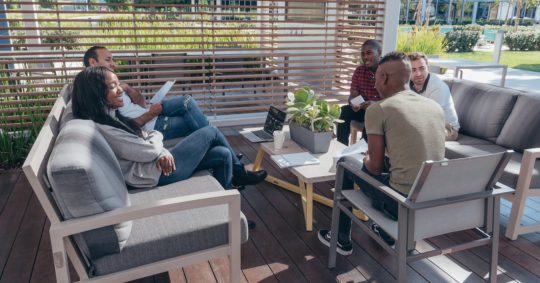News Bridge
We Bridge the Gap in World News
Beyond Open Offices For Productive Work Environments
Posted on October 31, 2023 in Blogging
The modern workplace is evolving rapidly, driven by changing work styles, technological advancements, and a growing emphasis on employee well-being and productivity. Traditional office layouts are making way for innovative design trends that foster collaboration, creativity, and a better work experience. In this article, we will explore the shift “Beyond Open Offices” and delve into the innovative design trends shaping productive work environments.

The Open Office Dilemma
Open offices were once heralded as the solution to create more collaborative and interactive workspaces. However, they came with their set of challenges. Noise, distractions, and a lack of privacy decreased productivity and employee dissatisfaction. Recognizing these issues, organizations began to rethink their office designs. As a result, the “Beyond Open Offices” movement emerged, focusing on alternative workplace designs that balance collaboration and individual work, catering to the diverse needs of employees.
1. Activity-Based Workspaces
Activity-based workspaces are designed to provide employees with various settings tailored to different tasks and preferences. Rather than assigning fixed desks, employees can choose the type of workspace that suits their work on a given day by utilizing rented office space for rent. These spaces may include open work areas for collaboration, quiet zones for focused work, and relaxation areas for breaks. By offering a range of environments, activity-based workspaces empower employees to be more productive and creative. They can select the setting that best aligns with the task, enhancing their comfort and output.
2. Biophilic Design
Biophilic design integrates elements of nature into the workplace, recognizing the positive impact of nature on well-being and productivity. Incorporating natural materials, greenery, and access to natural light, this trend aims to create a more inviting and inspiring work environment. Studies have shown that biophilic design can reduce stress, increase creativity, and boost overall job satisfaction. Employees in spaces with biophilic elements tend to be more engaged and productive, making this trend a valuable addition to modern workplaces.
3. Flexibility and Modular Furniture
Flexible and modular furniture is a critical component of innovative office design. These adaptable furnishings can be easily rearranged and reconfigured to meet changing needs. With remote work becoming more prevalent, flexibility in the physical workspace is crucial. Modular furniture enables organizations to optimize their office layouts, accommodating team sizes and project requirements. It also supports a more agile and responsive approach to workspace management.
4. Privacy Pods and Focus Rooms
Privacy pods and focus rooms provide employees with dedicated spaces for concentrated work, private meetings, or confidential discussions. These enclosed spaces address the need for privacy in open offices and remote work. Privacy pods can be equipped with soundproofing materials, comfortable seating, and technology to facilitate individual or small-group work. They offer a refuge for employees seeking a quiet, distraction-free environment.
5. Technology Integration
Technology shapes modern work environments, from traditional offices to coworking spaces. Integrating smart devices, video conferencing tools, and collaborative software has become essential for seamless communication and productivity. Innovative design trends include incorporating technology hubs, wireless charging stations, and interactive whiteboards. These features empower employees to work efficiently and stay connected, whether they are in the office or working remotely, within a coworking space or a traditional office setting.
6. Employee Wellness Zones
Employee well-being is a top priority for organizations looking to attract and retain talent. To support physical and mental health, many workplaces are now incorporating wellness zones into their designs. These areas may include fitness facilities, meditation rooms, and spaces for relaxation or socialization. Investing in employee wellness not only fosters a healthier workforce but also boosts morale and job satisfaction. It demonstrates a commitment to the holistic well-being of employees beyond just their work tasks.
7. Sustainable and Eco-Friendly Design
Sustainability is no longer an option but a necessity in office design. Organizations are increasingly adopting eco-friendly practices and materials to reduce their carbon footprint. This includes energy-efficient lighting, recycled materials, and sustainable building practices. Sustainable design not only aligns with environmental goals but also contributes to a healthier and more responsible corporate image.
8. Inclusive and Accessible Design
Inclusivity is a fundamental aspect of modern office design. Spaces must be accessible and accommodating for individuals of all abilities. Inclusive design principles ensure everyone can navigate and use the workspace comfortably and effectively. Adjustable desks, ergonomic seating, and accessible entryways are just a few elements of inclusive design that cater to a diverse workforce.
9. Art and Aesthetics
Art and aesthetics are increasingly recognized as powerful tools for enhancing workplace creativity and engagement. Integrating art into office spaces can stimulate creative thinking and provide visual interest. Many organizations are collaborating with local artists or curating art collections to elevate the aesthetic appeal of their offices. Art not only enhances the physical environment but also contributes to the overall culture and identity of the workplace.
10. Data-Driven Design
The data-driven design uses analytics and workplace sensors to gather space-use insights. This information can inform decisions about optimizing layouts, improving energy efficiency, and enhancing employee experiences. By leveraging data, organizations can create more efficient and employee-centric workspaces that respond to real-time needs.
The “Beyond Open Offices” movement reflects a shift in workplace design towards creating environments that prioritize employee well-being, productivity, and adaptability. These innovative design trends cater to the evolving needs of the modern workforce, which values flexibility, inclusivity, and sustainability. As organizations continue to embrace these trends, the future workplace will be a dynamic and responsive space that empowers employees to do their best, whether in the office or remotely. By investing in innovative design, organizations can foster a culture of creativity, collaboration, and well-being that drives success in a rapidly changing world.









